![]()
|
Crown Staffordshire Porcelain Co Ltd Crown
Staffordshire China Co Ltd
|
Location and period of operation:
|
Crown Staffordshire Porcelain Co Ltd |
Fenton |
1889 |
1948 |
|
Crown Staffordshire China Co Ltd |
Fenton |
1948 |
1985 |
China manufacturer at the Minerva
Works, Park Street, Fenton,
Stoke-on-Trent, England.
|
Formerly: T.A. & S. Green
Jump to:
| Obituary of Mr Alfred Spencer Green |
|
Advertisements |
| Examples of Crown Staffordshire ware |
| Early patterns in the style of Crown Derby, Worcester, Coalport | Brussels International Exposition 1910 |
| China floral ornaments | Designer John Bromley | Koryo Pottery |
| Marks used on ware for identification |
| the origin of the Crown Staffordshire intertwined script device |
| early development of the Crown Staffordshire marks |
| Why 'established 1801' | Minerva Works |
Obituary of Mr Alfred Spencer
Green
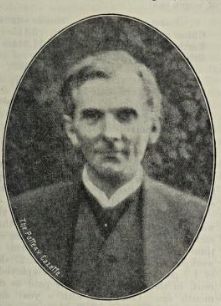
Mr Alfred Spencer Green
Aged 41
|
The works flag of the Crown Staffordshire Porcelain Co., Ltd., Fenton, floated at half-mast to signalise the passing on Sept. 27 [1913], at the Longton Cottage Hospital, in the prime of life, of Mr. Alfred Spencer Green, one of the firm’s esteemed managing directors. The deceased had not been enjoying really good health for some time past, but the beginning of the end was marked when he was recently seized with an attack of pleurisy, followed, before he could quite overcome it, by complications calling for his admission to the Longton Cottage Hospital. An operation was considered necessary and was successfully performed, after which, however, his strength was not sufficient to sustain him, and the end came. Mr. Alfred Spencer Green was the eldest son of the late Mr. Spencer Green, who was himself a manufacturer and a former chairman of the old Urban District Council. The whole of the deceased’s business career, extending in all over some 28 years, was devoted to the Minerva Works, many years of his service being spent in the capacity of works manager, and more recently (since 1903) he occupied the important position of managing director. He was a gentleman who was not satisfied with mere rule of thumb in his direction of the pottery, but always endeavoured to solve his difficulties and press forward from a scientific point of view, recognising that principles would remain when recipes were lost and forgotten. With this end in view he was for many years an ardent student of the Pottery Classes held under the auspices of the Staffordshire County Council, and since 1905 enjoyed membership in the English Ceramic Society, in whose proceedings he was always enthusiastically interested. Next to the relatives of the deceased who are left to sorrow his loss, perhaps none will lament him more than the workpeople whom he so considerately directed, for he was ever reasonable and patient in his bearing, and worked with the whole of his staff as a colleague, although he was in reality their director. The pensive memories occasioned amongst the workpeople by his sad demise may perhaps best be gathered by the course of events. Over eighty of the male employees were present at the interment to witness the last sad rites, and the workpeople as a body contributed liberally towards the floral tributes. Not satisfied with this, we learn that a deputation waited upon the deceased's brother directors and craved permission to contribute to a more lasting testimonial of their sympathy. The deceased will not only be revered in the Potteries which he made his home, he will be sympathetically recalled by many of the London buyers, and more especially by dealers in the provinces, with whom at one time he came directly into touch, although he never preferred sustained travelling. We extend our condolences to his relatives, and in a special degree to his younger brothers, Mr. Samuel A. Green who acted with him as managing director, and Mr. Douglas Green, upon whose shoulders his mantle will fall in carrying on uninterruptedly the business of the Grown Staffordshire Porcelain Co., Ltd. The Pottery Gazette, 1st November 1913
|
Advertisements
|
Art
Porcelain
|
London Show Rooms : 49, Hatton Garden
|

Crown Staffordshire Porcelain
The Crown Staffordshire Porcelain Co Ltd
Manufactory and Showrooms
Minerva Works . Fenton . Stoke-on-Trent
Advert from the 1921 Pottery Gazette and Glass Trade Review Diary
|
Advert from 1947 Pottery Gazette Reference Book |
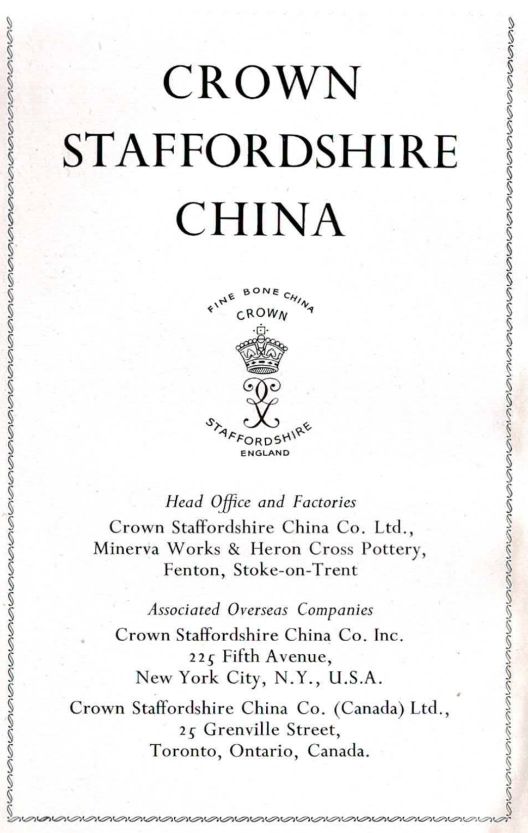 Crown Staffordshire China Crown Staffordshire China Co Ltd Minerva Works & Heron Cross Pottery Fenton Stoke-on-Trent Advert from 1956 Pottery Gazette Reference Book |
Examples of Crown Staffordshire ware:
|
By the turn of the 19th century, the company were producing a wide range of bone china products including dinner ware, tea and coffee ware, miniatures, vases, cutlery handles, door furniture and floral china baskets.
In
the late 1920s Crown Staffordshire pioneered the large scale production
of china floral ornaments and china costume jewellery for which they
became famous. 1929
Listed Exhibitor at the British Industries Fair. Manufacturers of Fine
English Bone China, Table Services of all kinds, China Flowers, Wicker
Baskets, Novelties in great variety. A wide range of decorations to suit
all Markets. Both before and during World War II the company produced badged-ware for the fighting services, including the British and Canadian navies. During the war they were designated as a nucleus firm (1941) which meant that they were allowed to continue trading in their own premises.
|
Early patterns in the style of Crown Derby, Worcester, Coalport
 "the Crown Staffordshire Co. have capable reproductions of old Chinese and Worcester scale and powder blue wares"
photos courtesy:
Clive Loader |
The gilding and floral bouquets of these cups & saucers are the same pattern elements used in the vase shown on the left.
mark
with the crown device and the word likely 1889-1891 |
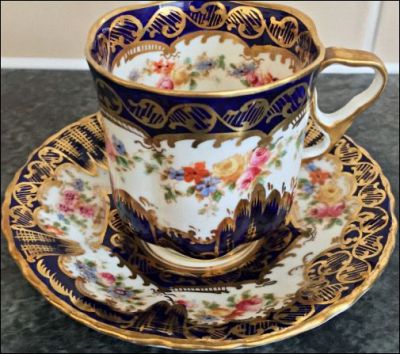
Floral Bouquets: Delicate and colorful hand-painted floral bouquets occupy the central white areas of both the cup and the saucer. Lavish Gilding: Intricate gold gilt patterning extensively highlights the design, particularly within the cobalt blue borders and accentuating the handle and rim of the cup, contributing to its luxurious and ornate appearance. This A807 pattern is said to have been registered in 1891
mark introduced 1906 |
| the origin of the Crown Staffordshire intertwined script device | early development of the Crown Staffordshire marks |
Brussels International Exposition 1910
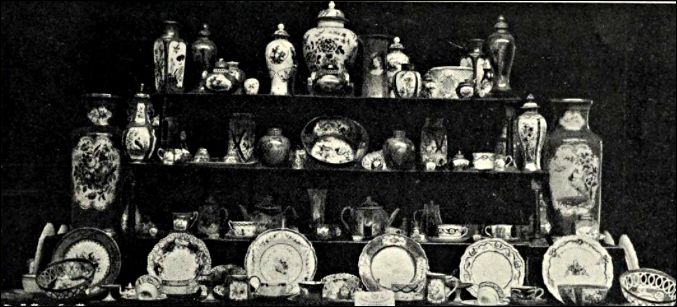
Crown Staffordshire
Porcelain display at the Brussels International Exposition 1910
|
Crown Staffordshire Porcelain joined 19 other "large firms" as part of the ceramic display in the British section of the 1910 Brussels International Exposition "The Crown Staffordshire Porcelain Co., Ltd., Fenton, show a varied collection of chinaware in their well filled case. Reproductions of seventeenth and eighteenth century decorations are perhaps the most numerous, but there are also a few revivals of the old Chinese “ Ming ” style and some delicate pierced bowls. This firm are very successful with their powdered blue ground, and they also use some dainty miniature and landscape decorations."
|
China floral ornaments
|
In the late 1920s Crown Staffordshire pioneered the large scale production of china floral ornaments and china costume jewellery for which they became famous. In 1952 the Crown Staffordshire China Co. Ltd. was described by the Pottery Gazette and Glass Trades Review as the largest producer of china flowers in the Potteries as well as producing many figure and bird studies. Over 200 people were employed in the factory's decorating department. |
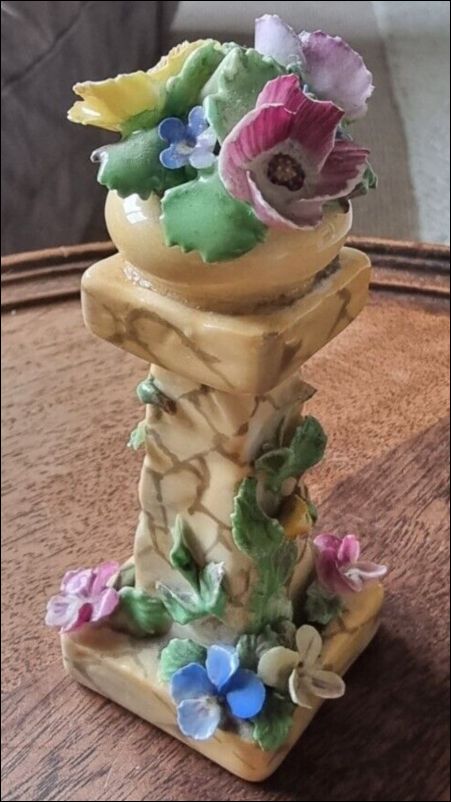
|
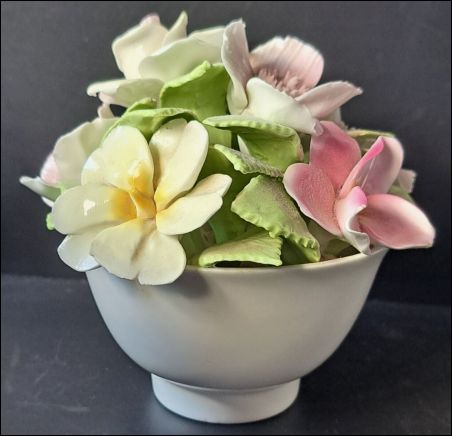
|
Designer John Bromley

a range of Crown Staffordshire
birds sculpted by John Bromley
|
|
John was a freelance designer/modeller who studied Design at the Stoke-on-Trent College of Art. He produced designs for a number of quality ceramic manufacturers including: Royal Doulton, Crown Staffordshire China, Coalport, Wedgwood, Royal Worcester.
(not to be confused with the artist John Mallard Bromley)
|
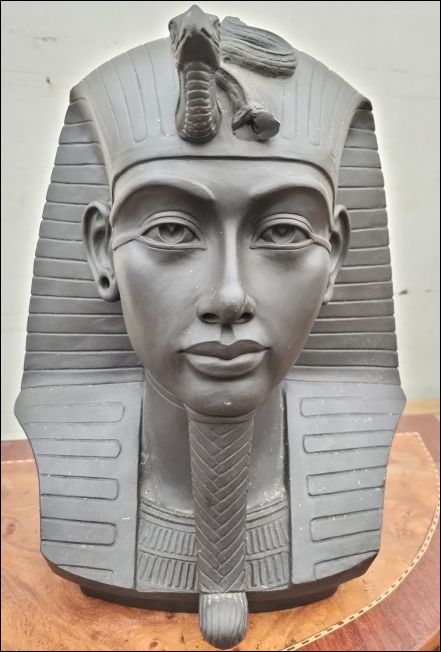 |
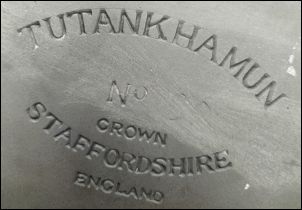 Tutankhamun Crown Staffordshire England
Black basalt bust of the Egyptian pharaoh Tutankhamun -this bust by the sculptor John Bromley was based on the gold death mask discovered by Howard Carter. Bromley produced other black basalt busts including Winston Churchill and Golda Meir. |
photos courtesy: Claire Brooks
Koryo Pottery
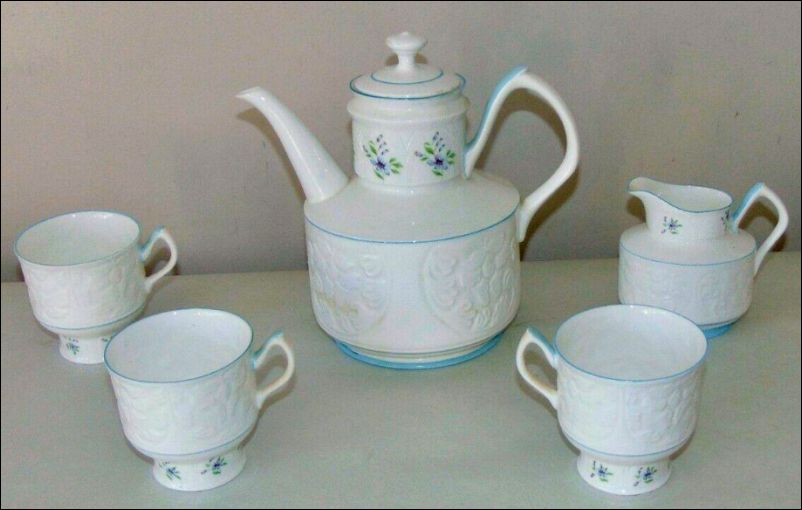
"Koryo Pottery 12th Century" was a backstamp used by Crown Staffordshire
|
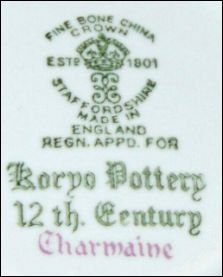 Fine Bone China Crown Staffordshire Koryo Pottery 1930+ |
Ware for the Armed Forces
|
fragment found 2021 on Bridlington Beach, East Riding of Yorkshire by Andy Haddock and his grandson Austin Colinson. |
Royal Navy Mess Ware (canteen ware) was manufactured for use on board vessels and in institutions belonging to the Royal Navy. Different patterns and markings were used for the various ranks and ships. In
1907 the Royal Navy went to general mess after which all crockery through out the navy was the same. The example shown is the Crown Staffordshire manufacturers mark with the Royal Navy Government inspection & approved stamp consisting of a capital A above a fouled Anchor with the inspection number 0 below.
|
|
This
insignia and top-mark used on all British Royal Navy dinnerware from about 1937 onward. This
top-mark consists of a fouled anchor within a badge surrounded by an inscription
which translates to "The Seal of the Office of the Lord High Admiral of Great Britain, etc", with the British Royal Crown sitting above the badge. This particular insignia includes the King's crown of George VI as part of the Naval Badge. |
 Crown Staffordshire England Leadless Glaze c.1937-48
This cup was found during a dive in Loch Sunart - a sea loch on the west coast of Scotland. |
photo courtesy: Kym Parry
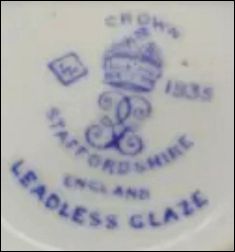 Crown Staffordshire 1935 The ‘W’ within the diamond indicates that the products were commissioned and produced for the Office of Works (until 1939) |
|
|
The marks shown indicates that the ware was produced for and supplied to the British Government; it was ultimately property of the Crown/Government, hence the 'W' on the 1935 example and the GR-VI Cypher on the 1945 example. This mark is there to distinguish the piece from being normal ‘utilitarian’ ware for public sale during the period surrounding the Second World War. Crown Staffordshire (and others) were given government contracts throughout the late 1930s and into the 1940s (WWII) and produced canteen ware - most likely for the armed services. The year of manufacturer is generally included. |
Marks used on ware for
identification:
From 1876 the business was in the hands of the brothers Thomas Allen Green and Spencer Green, in 1889 they started to trade as the Crown Staffordshire Porcelain Co but with reference to the proprietors T.A. & S. Green This table is the sequence of patterns registered to the occupiers of the Minerva China Works. Fenton - showing the transition from TA & S Green to Crown Staffordshire Porcelain Co (Ltd) |
| Registration date | Registration No | |
| 5 July 1888 | 104096 | Green, TA & S |
| 24 September 1891 | 179250 | Green, TA & S |
| 13 March 1895 | 251273 | Green, TA & S |
| 23 July 1897 | 302032 | Green, TA & S |
| 31 March 1900 | 355524 | Crown Staffs. Porcelain Co |
| January 1907 | 491997 | Crown Staffs. Porcelain Co Ltd |
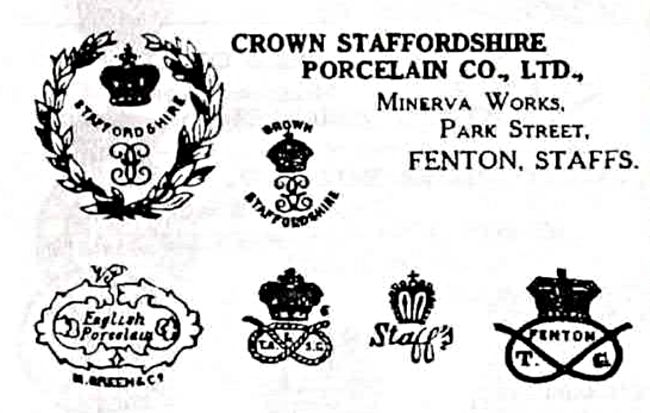
Marks listed in the 1917 Pottery Gazette and Glass Trade Review Diary
the origin of the
Crown Staffordshire intertwined script device
|
In 1889 the brothers Thomas Allen Green and Spencer Green started to trade as the Crown Staffordshire Porcelain Co. Doubtless this was an attempt to capitalise on the popularity of Crown Derby and the building of new Crown Derby factory in 1877. English manufacturers of quality porcelain were not adverse to copying the likeness of marks of successful manufacturers.
While not a direct copy the Crown Staffordshire script mark bears more than a passing resemblance to the Crown Derby mark which was newly introduced around 1887. |
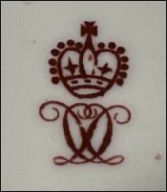
Crown
Derby mark
|
 Crown Staffordshire mark introduced c.1891 |
early development of the Crown Staffordshire marks
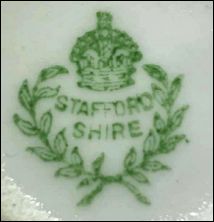
mark with the crown device and the word "Staffordshire" surrounded by a laurel wreath likely around the 1889-1891 period |
likely 1891-1906 the registration number 179250 shows that the pattern was first registered in 1891 examples ware in this pattern with silver Rococo style mounts with hall marks from the 1895-1902 period are known |
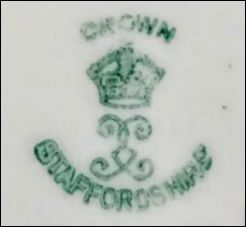
mark
with the crown device and mark introduced 1906
|

Crown device with Staffs
England
1906+
the registration number 589090
shows that the pattern was first registered in 1911
 Crown Staffordshire England |
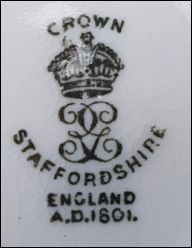 Crown Staffordshire England A.D. 1801 |
 Crown Staffordshire Estd 1801 Made in England the registration number 592627 shows
that the pattern was first registered in 1911 |
 Crown Staffordshire Estd 1801 Made in England |
this style of
mark without the laurel leaves but with the
intertwined script device was introduced in 1906
marks sometimes included 'England' 'Made in England' 'Estd 1801'
 Royal Victory Est 1801 Fine Bone China England |
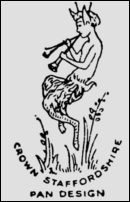 Crown Staffordshire Pan Design |
1930+
these and other marks used for special patterns


Fine Bone China
Crown Staffordshire
1930+
Standard printed back
stamp which
were used from
the 1930's onwards,
incorporating the words
"Fine Bone China"
there were slight variations
over the years.
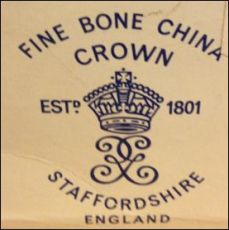 mark on packaging |
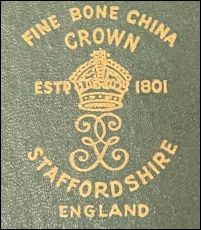 mark on presentation box |
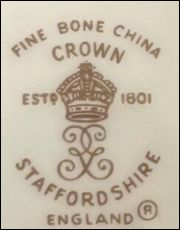 mark on presentation butter plate |
Fine Bone China
Crown
Staffordshire
England
Estd 1801
1930+
Standard mark which
were used from
the 1930's onwards,
incorporating the words
"Fine Bone China"
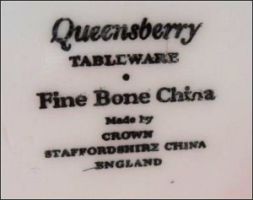 Queensberry Tableware Fine Bone China made by Crown Staffordshire China England c.1956+ |
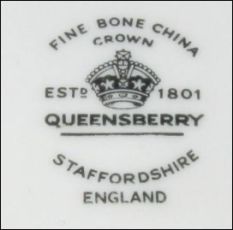 Fine Bone China Crown Staffordshire England Estd 1801 Queensberry c.1962+ |
'Queensberry' was a trade name
used by Crown
Staffordshire China from at least 1951 onwards
Minerva Works
Park Street
Fenton
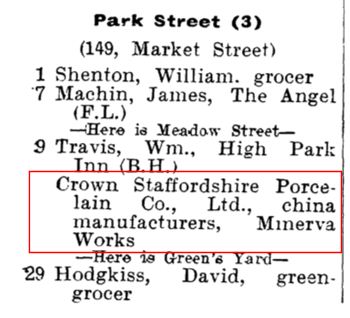
Crown Staffordshire
Porcelain Co. Ltd.
China manufacturers,
Minerva Works
from..... 1907
Staffordshire Sentinel
'Business Reference Guide to The Potteries, Newcastle & District'
c.1967-69 photographer:
Bert Bentley
Stoke-on-Trent City Archives
Source: Staffordshire Past Track
- click for more
on the Minerva Works -
Questions, comments, contributions? email: Steve Birks